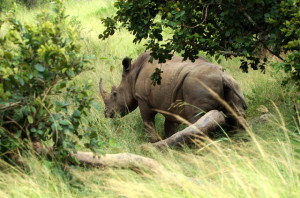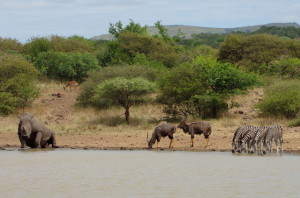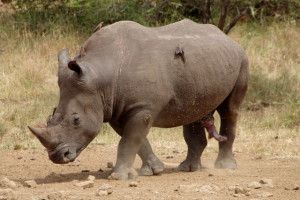
Before you, an African savannah, lined with tall, yellow grasses and dotted with prickly acacia trees. To your left, a river zigzagging through the bush, and off in the distance, a burning red sun beginning to dip below a patchy green hilltop. You adjust the focus on your binoculars and squint a bit more, trying to squeeze in a few more minutes of safari time before the sun fully sets and the park gates close. It’s your second evening in Hluhluhwe-Imfoloze National Park, in Kwazulu-Natal, and you still haven’t seen the creature the park is famed for.
Then, suddenly, you spot a bulky, dark silhouette moving slowly toward you. Could it be? No, it couldn’t. And yet…
 As the bulk becomes clearer, you are able to distinguish a large, dipped head bearing two distinct horns. Slowly, the mystical white rhino reveals himself in full, massive form and turns to face you, gigantic-head-on.
As the bulk becomes clearer, you are able to distinguish a large, dipped head bearing two distinct horns. Slowly, the mystical white rhino reveals himself in full, massive form and turns to face you, gigantic-head-on.Thump. Thump. Thump. The beating of your heart.
The rhino, nearly blind, nevertheless senses an unnatural presence. Nervously, he sniffs the air, trying to catch the scent of this strange intruder. His long ears spike up and dart in each direction as he carefully listens to the sound of your motor, your breathing, the beating of your agonizingly loud heart. Nerves getting the better of him and he darts off, more quickly than you’d expect for a creature so large; before you know it, he’s gone.
 It is hard to describe the experience of encountering a rhino in the wild. Of how mesmerizing and humbling it is to come up close to his gigantic body, impressive horns, and gentle eyes. Perhaps you, the reader, think you get it. But closing your eyes and imagining it in your mind, or seeing it in a National Geographic magazine or television program doesn’t hold a candle to the real-life, up-close safari experience. These prehistoric beasts are simply awesome.
It is hard to describe the experience of encountering a rhino in the wild. Of how mesmerizing and humbling it is to come up close to his gigantic body, impressive horns, and gentle eyes. Perhaps you, the reader, think you get it. But closing your eyes and imagining it in your mind, or seeing it in a National Geographic magazine or television program doesn’t hold a candle to the real-life, up-close safari experience. These prehistoric beasts are simply awesome.And yet, as fast as my first white rhino disappeared into the sunset, these gentle giants are disappearing from the face of this planet. And the sole biggest factor is poaching.
 For a long time now, man and animal have been playing a game of poker. Animals keep losing, and with each round, they hand over a bit more of their material wealth – land. Most animal species worldwide have been in decline for years, mainly because of our constant infringement on their land. Yet, in the mid-20thcentury, people finally got the idea that animals – the rhino among them – were worth saving, and we began making concerted efforts to preserve large pieces of land and restocking them with threatened and endangered animals. In South Africa, the African rhino (consisting of 2 species, white and black) started to recover in number. This was an amazing success for conservationists, who, with 93% of white and black rhinos worldwide within their borders, leapt with confidence into the 21st century.
For a long time now, man and animal have been playing a game of poker. Animals keep losing, and with each round, they hand over a bit more of their material wealth – land. Most animal species worldwide have been in decline for years, mainly because of our constant infringement on their land. Yet, in the mid-20thcentury, people finally got the idea that animals – the rhino among them – were worth saving, and we began making concerted efforts to preserve large pieces of land and restocking them with threatened and endangered animals. In South Africa, the African rhino (consisting of 2 species, white and black) started to recover in number. This was an amazing success for conservationists, who, with 93% of white and black rhinos worldwide within their borders, leapt with confidence into the 21st century.
Yet, something strange started to happen. Rhino carcasses with bloody stumps in the place of horns started to become common finding amongst rangers making their daily rounds. Eighty-three corpses showed up in 2008, one-hundred and twenty-two in 2009, and three hundred and thirty-three in 2010. South African National Parks and reserves were starting to look like massive war grounds. When four-hundred and forty-eight gory rhino cadavers were found in 2012, it was official – war had been declared on the rhino, and they were losing.
 It is said that one rhino is killed every 20 hours. That means that since the time I saw my first rhino a couple short weeks ago, 12 more have been killed. I’ve seen 36 rhinos in all so far, but a third of them might have since suffered a horrible, violent death. At this rate, the black and white rhinos will be completely wiped out in South Africa in 15 short years – all 20,000 of them. And they will be extinct worldwide by the time my future children are my age.
It is said that one rhino is killed every 20 hours. That means that since the time I saw my first rhino a couple short weeks ago, 12 more have been killed. I’ve seen 36 rhinos in all so far, but a third of them might have since suffered a horrible, violent death. At this rate, the black and white rhinos will be completely wiped out in South Africa in 15 short years – all 20,000 of them. And they will be extinct worldwide by the time my future children are my age. What is the poaching epidemic all about? It turns out that rhino horn powder is valued as a cure-all medication in China and Vietnam. This is an ancient superstition, and poaching rhino for their horn has existed since time immemorial. Yet, with the rise of the middle class in the Far East, more people can afford this powder, which is now worth more, ounce per ounce, than cocaine or gold. Of course, rhino horn is actually composed of only calcium, melanin, and keratin, so it’s no different than hair follicles or fingernails – which means it’s completely useless at curing fever, cancer, or impotence. But try telling that to the Chinese.
What is the poaching epidemic all about? It turns out that rhino horn powder is valued as a cure-all medication in China and Vietnam. This is an ancient superstition, and poaching rhino for their horn has existed since time immemorial. Yet, with the rise of the middle class in the Far East, more people can afford this powder, which is now worth more, ounce per ounce, than cocaine or gold. Of course, rhino horn is actually composed of only calcium, melanin, and keratin, so it’s no different than hair follicles or fingernails – which means it’s completely useless at curing fever, cancer, or impotence. But try telling that to the Chinese. Of course, there is much more to the issue of rhino poaching than meets the eye. South Africa is guilty of not enforcing stiff enough penalties for poachers that are caught. In 2011, there were almost 200 poaching-related arrests, but with a conviction rate of only 3% and sentences usually ranging from fines to hunting bans, there is little incentive for poachers to stop. Indeed, rhino horn poaching is seen as a low-risk, high reward profession. I say profession, because pilots, war veterans, game farmers, and other industry experts are often the ones committing these heinous crimes. These professionals often use high-tech equipment such as automatic weapons, silencers, night vision, and air support to move in, skillfully remove the horn, and efficiently disappear, long before rangers spot the injured or dead animal.
Of course, there is much more to the issue of rhino poaching than meets the eye. South Africa is guilty of not enforcing stiff enough penalties for poachers that are caught. In 2011, there were almost 200 poaching-related arrests, but with a conviction rate of only 3% and sentences usually ranging from fines to hunting bans, there is little incentive for poachers to stop. Indeed, rhino horn poaching is seen as a low-risk, high reward profession. I say profession, because pilots, war veterans, game farmers, and other industry experts are often the ones committing these heinous crimes. These professionals often use high-tech equipment such as automatic weapons, silencers, night vision, and air support to move in, skillfully remove the horn, and efficiently disappear, long before rangers spot the injured or dead animal. 
 Putting an end to rhino poaching is an incredible challenge, as the issue is more complex than it may initially seem. It is easy to say that there need to be bigger repercussions for perpetrators as well as better policing of conservation areas. It is easy to say that we need to educate Asians in order to wipe out the fallacy that rhino horn is medicine. But all of these solutions are easier said than done. Some people endorse deterrents such as cutting the horns off the rhinos to make them valueless to poachers. But with the cost of cutting a single rhino’s horns at roughly $1000, and the fact that – just like hair or fingernails – the horns eventually grow back, this strategy isn’t the most effective. Another deterrent method is to poison the horn, putting the Asian consumer at risk. But this poison has caused negative side effects in rhinos, such as nausea, vomiting, and convulsions, so it’s not a truly realistic option (and this is without mentioning the possible legal repercussions of purposely poisoning a human being). The most radical idea is to legalize the international rhino trade, conducting proper removal of horns without harming the rhino. Proponents of this idea claim that not only would it reduce world market price of rhino horn and deter would-be poachers, but it is an economically and environmentally viable option. Yet, are 28,000 rhinos worldwide enough to sustain the ever-growing demands of China and Vietnam, which contain almost half the world’s population?
Putting an end to rhino poaching is an incredible challenge, as the issue is more complex than it may initially seem. It is easy to say that there need to be bigger repercussions for perpetrators as well as better policing of conservation areas. It is easy to say that we need to educate Asians in order to wipe out the fallacy that rhino horn is medicine. But all of these solutions are easier said than done. Some people endorse deterrents such as cutting the horns off the rhinos to make them valueless to poachers. But with the cost of cutting a single rhino’s horns at roughly $1000, and the fact that – just like hair or fingernails – the horns eventually grow back, this strategy isn’t the most effective. Another deterrent method is to poison the horn, putting the Asian consumer at risk. But this poison has caused negative side effects in rhinos, such as nausea, vomiting, and convulsions, so it’s not a truly realistic option (and this is without mentioning the possible legal repercussions of purposely poisoning a human being). The most radical idea is to legalize the international rhino trade, conducting proper removal of horns without harming the rhino. Proponents of this idea claim that not only would it reduce world market price of rhino horn and deter would-be poachers, but it is an economically and environmentally viable option. Yet, are 28,000 rhinos worldwide enough to sustain the ever-growing demands of China and Vietnam, which contain almost half the world’s population?
I don’t know what the ultimate solution to rhino poaching is, but I do hope there is one, and soon. In the last two weeks, I’ve watched rhinos wade in the mud for hours, waking only to scratch hard-to-reach places (of which there are a lot!) on trees (of which there are not so many anymore, but that’s another story). I’ve watched rhino males unsuccessfully try to steal other male rhinos’ women, and the resulting intimidation charges the efforts ensue. I’ve watched rhinos nap, legs tucked carefully under their massive bodies, as oxpecker birds rid them of parasites. I’ve seen rhinos rub horns and faces as they show each other tenderness and affection, and I’ve seen them pee endless gallons of urine onto the muddy earth. I’ve seen them from far and I’ve seen them up-close. And my awe has never waned. It’s cliché to say, but I want future children to experience them the way I have these past two weeks. More than that, I want them around because they have been on the earth for 50 million years and are an integral part of its history. They deserve to be here, just as much as we do. We cannot be the cause of their disappearance.
 And so rhino poaching must be talked about, must be publicized, must be made into a media frenzy so large that officials at local, national and international levels cannot ignore the problem anymore. If you want to do something, write to your embassy or local government official or talk about it on social media outlets like Facebook and Twitter. If you want to do a bit more, become a Wildside Warrior at wildsidesa.co.za or donate to Project Rhino KZN or the African Conservation Trust. Or do something crazy like jumping off a plane for Skydive for Rhinos or sending nail clipping and cut hair to Stop Poaching our Rhinos, a grassroots organization that dumps large quantities of the stuff at the Chinese and Vietnamese Embassies (rodneytherhino@gmail.comfor more info). If you want more information on the rhino poaching issue, visit savingrhinos.org, ewt.org.za, or stoprhinopoaching.com . Together, we can – and must – make a difference. The rhino is counting on us.
And so rhino poaching must be talked about, must be publicized, must be made into a media frenzy so large that officials at local, national and international levels cannot ignore the problem anymore. If you want to do something, write to your embassy or local government official or talk about it on social media outlets like Facebook and Twitter. If you want to do a bit more, become a Wildside Warrior at wildsidesa.co.za or donate to Project Rhino KZN or the African Conservation Trust. Or do something crazy like jumping off a plane for Skydive for Rhinos or sending nail clipping and cut hair to Stop Poaching our Rhinos, a grassroots organization that dumps large quantities of the stuff at the Chinese and Vietnamese Embassies (rodneytherhino@gmail.comfor more info). If you want more information on the rhino poaching issue, visit savingrhinos.org, ewt.org.za, or stoprhinopoaching.com . Together, we can – and must – make a difference. The rhino is counting on us.

